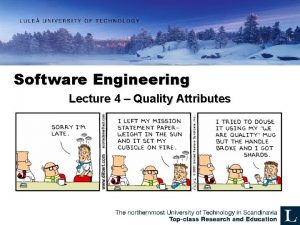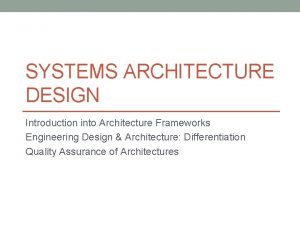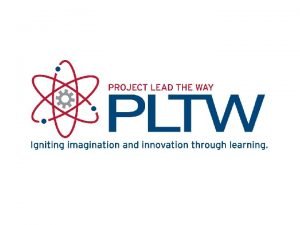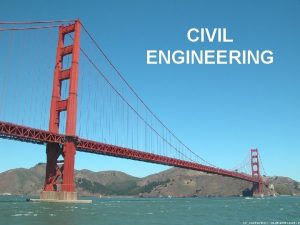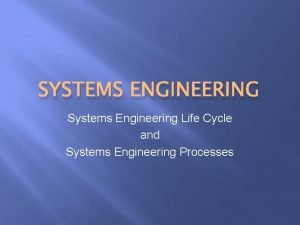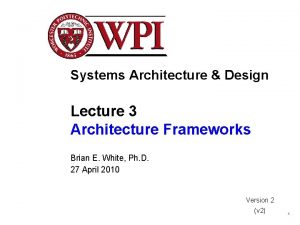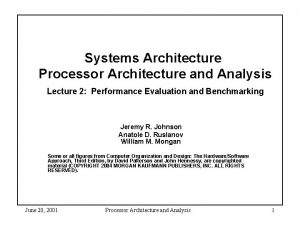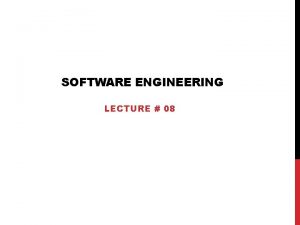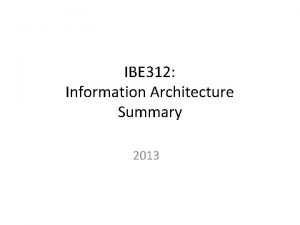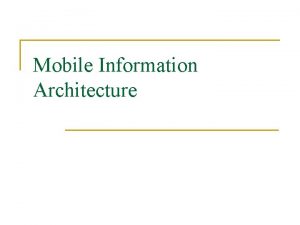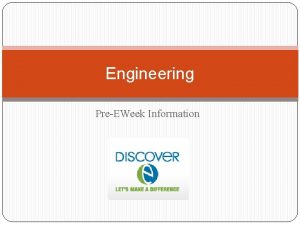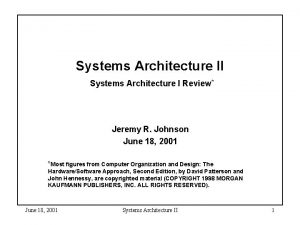Information Systems Engineering Lecture Outline Information Systems Architecture



























- Slides: 27

Information Systems Engineering

Lecture Outline • • • Information Systems Architecture Information System Architecture components Information Engineering Phases of Information Engineering Features of Information Engineering INFORMATION SYSTEM ENGINEERING 2

Information Systems(IS) Planning Introduction : • Sometimes called “enterprise-wide computing” or “Information Architecture” • Scope of (IS Planning) is now the entire organization • There is a problem: isolated groups in an organization start their own databases and it becomes impossible to find out who has what information, where there are overlaps, and to assess the accuracy of the information • To support enterprise-wide computing, there must be enterprise-wide information planning • One framework for thinking about and planning for enterprise-wide computing is an Information Systems Architecture or ISA • Most organizations do NOT have such an architecture INFORMATION SYSTEM ENGINEERING 3

Information Systems Architecture (ISA) • An ISA is a “conceptual blueprint or plan that expresses the desired future structure for information systems in an organization” • It provides a “context within which managers throughout the organization can make consistent decisions concerning their information systems” INFORMATION SYSTEM ENGINEERING 4

Benefits of ISA – Provides a basis for strategic planning of IS – Provides a basis for communicating with top management and a context for budget decisions concerning IS – Provides a unifying concept for the various stakeholders in information systems. – Communicates the overall direction for information technology and a context for decisions in this area – Helps achieve information integration when systems are distributed – Provides a basis for evaluating technology options (for example, downsizing and distributed processing) INFORMATION SYSTEM ENGINEERING 5

Zachman ISA Framework components – Data • The “What” of the information system – Process • The “How” of the information system – Network • The “Where” of the information system – People • Who performs processes and are the source and receiver of data and information. – Events and Points in time • When processes are performed – Reasons • Why: For events and rules that govern processing INFORMATION SYSTEM ENGINEERING 6

Roles of Data, Process and Network • Six perspectives of the Data, Process and Network components – Business scope (Owner) – Business model (Architect) – Information systems model (Designer) – Technology model (Builder) – Technology definition (Contractor) – Information system (User) INFORMATION SYSTEM ENGINEERING 7

Explanation of the components Data List of entities important to the business Process List of processes or functions that the business performs Network List of locations in which the business operates 1. Enterprise Scope (Owner) INFORMATION SYSTEM ENGINEERING 8

Explanation of the components (contd…. ) Data Business entities and their relationships Process Function and process decomposition Network Communications links between business locations 2. Enterprise Model (Architect) INFORMATION SYSTEM ENGINEERING 9

Explanation of the components (contd…. ) Data Process Model of the business data and their relationships (ERD in Database design) Flows between application processes Network Distribution Network 3. Information System Model (Designer) INFORMATION SYSTEM ENGINEERING 10

Explanation of the components (contd…. ) Data Process Database Design (logical) Process specifications Network Database Design 4. Technology Constrained Model (Builder) INFORMATION SYSTEM ENGINEERING 11

Explanation of the components (contd…. ) Database Schema and subschema definition Process Program Code and control blocks Network Configuration definition/ Network Architecture 5. Technology Definition/ Detailed Representations (Contractor) INFORMATION SYSTEM ENGINEERING 12

Explanation of the components (contd…. ) Data Implemented Database and information Process Implemented Application Programs Network Current System Configuration 6. Functioning Enterprise (User) INFORMATION SYSTEM ENGINEERING 13

Information Engineering • Information Engineering: “an interlocking set of formal techniques in which enterprise models, data models and process models are built. . . and are used to create and maintain Information Systems” James Martin (1986) INFORMATION SYSTEM ENGINEERING 14

Information Engineering (contd…. ) Object-oriented concepts Database technology (Relational, Hierarchical, Network ) Data oriented methodology Data analysis and data management Full lifecycle coverage Focus on data and activities The use of tools such as CASE(Computer Aided Software Engineering) • Note: CASE tools are a class of software that automate many of • • the activities involved in various life cycle phases INFORMATION SYSTEM ENGINEERING 15

Information Engineering (contd…. ) • Strategic data models • Alignment of information systems planning with strategic business planning • Process modeling techniques • top-down analysis and development of organization's applications INFORMATION SYSTEM ENGINEERING 16

Major Phases of Information Engineering 1. Information strategy planning to build an information and technology architecture to support business strategy and objectives 2. Business area analysis to identify data and function requirements of each business area 3. Individual systems planning 4. Individual Systems design to complete logical specifications for a system and convert these into physical design specifications 5. Construction to generate code, test, and install the system 6. Cutover INFORMATION SYSTEM ENGINEERING 17

Phase 1 - information strategy planning: • business mission, objectives, CSFs, performance measurements, organization structure, current situation • construct corporate data model • determine major business area/functions • determine: – information architecture (global entities and business area/functions ) – technical architecture (technology: HW/SW/Comm. ) – information strategy plan (priorities) INFORMATION SYSTEM ENGINEERING 18

Phase 2 - Business Area Analysis The Business Area Analysis must help in the following: • identify and model in detail the fundamental data and activities required to support a business area • ensure that requirements enable business area’s goals and CSFs to be supported • ensure that requirements are independent of : – technology – current systems and procedures – current organizational structure • a high-level executive sponsor is necessary INFORMATION SYSTEM ENGINEERING 19

Business area analysis: steps • extract the relevant entity relationship model and businessfunction decomposition models • identify relevant departments, locations, business goals, CSFs • create a preliminary data model: identify events, entity life cycles, initial attributes • create a preliminary process model: decompose the functions into processes • model data and processes of existing systems for comparison • involve all affected end-users in iteratively building: a detailed data model, a detailed process model, entity / process matrices • identify and priorities system development projects INFORMATION SYSTEM ENGINEERING 20

Business area analysis: techniques • data model entity relationship modeling attribute collection normalization canonical synthesis • process model process decomposition models process dependency diagrams • data and activity interaction entity lifecycles process / entity matrix INFORMATION SYSTEM ENGINEERING 21

Information engineering: phases 3 and 4 • Phase 3 - individual systems planning Although it is individual but we have to use JRP (Joint Requirement Planning) for individual systems planning • Phase 4 - individual system design • concerned with how selected processes in the business are implemented in procedures and how these procedures work • direct end-user involvement is essential • identify reusable procedures • use prototyping • use JAD (Joint Application Design) INFORMATION SYSTEM ENGINEERING 22

System design techniques 1. prototyping 2. detailed process models: procedure design using access path and volumes analysis, dialogue flows and menu structures, 3. physical database design, file design, 4. screen displays 5. menu flows 6. report layouts 7. batch procedures and software 8. design verification and testing INFORMATION SYSTEM ENGINEERING 23

Information engineering: phases 5 and 6 • Phase 5 - construction: technical design, create physical databases create modules and programs, unit testing system testing, documentation • Phase 6 - cutover: conversion final testing conduct training install the system, review implementation INFORMATION SYSTEM ENGINEERING 24

Information Engineering Features • organization-wide perspective aligned with strategic business planning • Comprehensive (complete, full) • emphasis on user involvement e. g. JAD, JRP • evolves by incorporating new techniques, concepts, technologies e. g. object-oriented concepts • emphasis on automation e. g. 4 GLs, I-CASE, prototypes INFORMATION SYSTEM ENGINEERING 25

Information Engineering Features (Contd…. ) • primarily for database transaction processing systems • flexible paths through the methodology engineering and re-engineering INFORMATION SYSTEM ENGINEERING e. g. reverse 26

References • Avison, D. E. & Fitzgerald, G. (2003). Information Systems Development: Methodologies, Techniques and Tools. (3 rd ed), Mc. Graw. Hill, London. Chapters 20. 1, 20. 3 • www. courses. ischool. berkeley. edu • www. slideserve. com/. . . /information-systems-planning- • www. ou. edu/class/aschwarz/Database/ INFORMATION SYSTEM ENGINEERING 27
 Principles of complex systems for systems engineering
Principles of complex systems for systems engineering Elegant systems
Elegant systems 01:640:244 lecture notes - lecture 15: plat, idah, farad
01:640:244 lecture notes - lecture 15: plat, idah, farad Lecture outline example
Lecture outline example Lecture outline example
Lecture outline example Lecture outline example
Lecture outline example Lecture outline meaning
Lecture outline meaning Sandwich paragraph example
Sandwich paragraph example Architecture lecture notes
Architecture lecture notes Isa definition computer
Isa definition computer Financial engineering notes
Financial engineering notes Requirement analysis in software engineering notes
Requirement analysis in software engineering notes Foundation engineering lecture notes
Foundation engineering lecture notes Professional ethics in engineering notes
Professional ethics in engineering notes Operating system lecture notes
Operating system lecture notes Articulators
Articulators Lecture sound systems
Lecture sound systems Software engineering 1 course outline
Software engineering 1 course outline Health management information system lecture notes
Health management information system lecture notes Payment systems outline
Payment systems outline Payment systems outline
Payment systems outline Mondex card
Mondex card Architecture business cycle
Architecture business cycle Return architecture
Return architecture Product architecture example
Product architecture example Product architectures
Product architectures Buses in computer architecture
Buses in computer architecture Gate general architecture for text engineering
Gate general architecture for text engineering





























